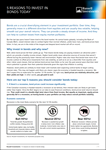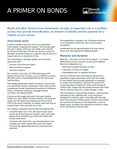Fixed income investing
Mitigate risk, diversify from equities, or find new avenues for income in your portfolios
What is fixed income?
Fixed income investments, or bonds, are simply loans to a corporation, municipality or government agency.
- The borrower gets the cash they need.
- The lender earns interest for the term of the loan.
- The borrower promises to pay a specific interest rate regularly until the loan matures.
- This steady, predictable stream of interest is why bonds are called “fixed income”.
Other examples of fixed-income investments include: Guaranteed Investment Certificates (GICs), investment contracts, mortgage-backed securities, and savings bonds. A convenient way to invest in bonds and diversify your bond portfolio is through a fixed income mutual fund.
Whether you’re looking to mitigate risk, diversify from equities, or find new avenues for income in your portfolios, fixed income can be your solution. From investment grade credit to liquid alternative strategies, discover the full offering of our fixed income solution set.

"There is an inverse relationship between bond market values and prices versus interest rates and yields."
As a general rule, when interest rates and yields rise, bond market values and prices fall. This means that bonds—particularly longer-term bonds—are highly susceptible to economic environments with rising interest rates.
Move the above levers up or down to see the relationship in action.
Four key advantages to investing in fixed income
There are advantages to consider when including fixed income assets into your investment portfolio:
ADVANTAGE 1
Diversify your equity exposure
Fixed income assets generally react in a different manner than equity to market events, providing an effective diversifier to your equity exposure.
ADVANTAGE 2
A source of income
Fixed income assets can be a source of income through interest or dividend payments.
ADVANTAGE 3
Help protect your principal
Fixed income assets generally retain their value over time as they are less likely to suffer large drawdowns.
ADVANTAGE 4
Smoother return profile
Through diversification and smaller drawdown potential, adding fixed income assets can help smooth out the returns of a portfolio.
How to invest in fixed income?
Fixed income still plays a key role in any portfolio—offering diversification, stability, and income potential. Our next generation of fixed income strategies takes advantage of global geographies, sectors, and third-party specialists to help enhance your returns.
A short-term fixed income solution for conservative investors seeking an alternative to money market or high interest savings accounts that invests primarily in Canadian fixed income.
A core fixed income solution providing effective diversification against equities and a stable level of cash flow that invests primarily in Canadian fixed income.
Provides exposure to Core, Plus and Liquid Alternatives strategies which aim to generate incremental returns. The Core component invests in Russell Investments Fixed Income Pool (45%), the Plus (47%) and Liquid Alternatives (8%) components invest in specialized strategies designed to generate incremental returns.
Related materials
Investor education
RECENT BLOG POSTS
Hear from our experts on the issues our clients care about most



